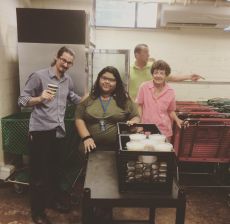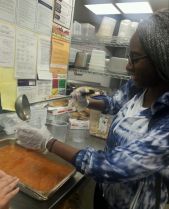Cabrini University is addressing food waste and hunger with the Food Recovery Network.

“When I was growing up, my mom struggled with keeping food on the table. My four siblings and I did not notice it, but we were living paycheck to paycheck just to buy food,” Katie Fazio said.
“I heard about the Food Recovery Network after taking an ECG 200 class with Professor O’Donnell, Hunger at your fingertips,” Fazio, junior childhood education major, said. “After taking the class, I stayed in contact with Professor O’Donnell and he asked if I would be willing to do more with this program. I replied, ‘Of course,’ and I took it from there and launched the Food Recovery Network at Cabrini’s involvement fair.”
The Food Recovery Network is also a larger organization and was founded by Ben Simon, Mia Zavalij and Cam Pascual in 2011. They were all college students at the University of Maryland and began to notice that large amounts of cafeteria food was going to waste. The network was originally for college students who either did not have access to food or had run out of their meal swipes or flex.

It then expanded to off-campus hunger issues when it gained enough member and meals. They collected the left-over food from each meal that would normally be thrown out at the end of the day.
According to the FoodRecoveryNetwork, t is the largest student movement against food waste and hunger, having recovered and donated more than 1.8 million meals for those in need.
Alexis Caputo, freshmen and early education major, said, “I joined this organization so early because people seemed so involved in it. It made me think we could really make a difference.”

“After the first ECG meeting I went to, I knew this was a program I wanted to be a part of,” Daisy Rodriguez, sophomore political science and criminology major, said. “The Pennsylvania area has a high rate of people experiencing homelessness. The Food Recovery Network is combating this by reusing food that would be normally thrown away.”
According to Whyy.org, the population of people experiencing homelessness has gone up by 1.6 percent in Pennsylvania as of 2015. The issue of homelessness is very prevalent not only in the Pennsylvania area, but in the world. Organizations like the Food Recovery Network are actively fighting against this issue and are becoming a necessity everywhere.
Fazio has had a first hand experience that relates to the Food Recovery Network. Her mother worked pay check to pay check to keep food on the table for her and her four siblings.
Fazio said, “My mom never personally had to go to a food bank but I just thought if I could help out some families who are struggling, then why not.”


